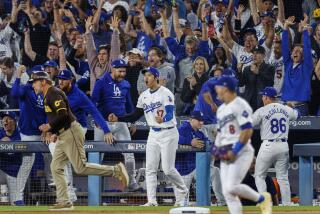A Homer Heaven for Hitters : Teeing Off On Pitchers Was the April Baseball Theme
- Share via
It just doesn’t pay to be a pitcher anymore, which may be why we have so few real ones.
The attack on pitchers began in 1969, a year after Bob Gibson posted a 1.12 earned run average and Carl Yastrzemski won the batting title with a .301 average.
First, they lowered the mound, reducing the angle of the delivery. Next, they added a designated hitter in the American League, eliminating at-bats for pitchers who were considered automatic outs anyway.
Finally, they decided to shrink the strike zone, taking a pinch off here and another one there, leaving a target that must seem like a pinhole for those poor souls standing 60 feet, 6 1/2 inches away from it. This season, they tried lowering the zone, adding some area to it. The change has had little effect. As the era of expansion dilutes the pitching talent pool, the hitters continue to tee off.
Consider the month of April when, within one week, hitters produced three of the biggest offensive days--April 24, April 28 and April 30--in the history of the game.
According to figures compiled by Elias Sports Bureau, the top offensive day in this century occurred on July 25, 1937 when in 13 games 183 runs were scored, an average of 14.07 per game. Last week, hitters averaged 13.93 runs on April 24, 13.92 on April 30 and 13.58 on April 28.
“You look at the out-of-town scoreboard and see 14, 15, 9, 10 runs all the time,” Yankees manager Joe Torre said. “It’s scary.”
April was a nightmarish month for pitchers. In 359 games, there were 826 home runs hit, an average of 2.30 per game, and 3,799 runs scored, an average of 10.58. That amounts to the most homers and most runs scored for any April in the last 10 seasons.
There were three games in which teams scored over 20 runs in a game, the first time that’s happened in 46 years. The cumulative earned run average for the two leagues was 4.77.
And April is traditionally a pitchers’ month because of the cold weather. When the weather warms up, what happens to sudden sluggers like Brady Anderson, who tied the record for homers in a month with 11? Gary Sheffield and Barry Bonds also had 11.
Multiple homers have become routine. Pittsburgh’s Jeff King hit two in an inning for the second time in his career. Seattle’s Ken Griffey, hit two in Toronto, the first an impressive 442 feet and the second even longer at 451 feet, according to statistics compiled by networkMCI, which measures distances for all major league homers.
Those were April homers. Pete Incaviglia of Philadelphia opened May with a 482-foot homer, the longest shot in the three years the company has been measuring.
“Pitchers are pitching real tentative, trying to throw a great pitch on the first pitch, then they’re behind 1-0,” said Marty Cordova, who was hitting .386 for Minnesota. “Then the next strike is going to get hit hard.”
Typical of the shabby pitching was the two-game series between the Baltimore Orioles and New York Yankees. First, the teams played the longest nine-inning game in history, a 4-hour, 21-minute affair won by the Yankees, 13-10. The two clubs went through 10 pitchers who gave up 28 hits--four of them homers--and 13 walks.
The next night, the same two teams played 15 innings and 5 hours, 34 minutes, exchanging seven intentional walks before the Yankees won 11-6 on a grand slam by Tino Martinez. Gerald Williams had six hits and Bernie Williams had five for New York. Lou Gehrig never had six hits in a game. Neither did Babe Ruth or Joe DiMaggio.
Minnesota’s Paul Molitor, who opened May batting .371, said he thinks even the umpires are noticing how bad the pitching has been, letting the strike zone grow during the course of a game.
“As runs are being scored and the games get longer, the zones get expanded,” he said. “I guess they (umpires) get a little impatient back there with some of the pitching they’ve seen early in the season, and that’s understandable.”
Perhaps the problem with pitching is a change in philosophy. Pitchers avoid working inside and the result is hitters becoming fearless at the plate. With the emphasis on bullpens, pitchers aren’t expected to throw complete games anymore.
“They say a quality start is six innings and three runs allowed,” Hall of Fame pitcher Jim Palmer said. “That’s a 4.50 ERA for nine innings.”
And to Palmer and pitchers of his generation, that’s questionable quality.
Better days may be ahead, though. There were three shutouts pitched on the first day in May.
Put away the beer keg. It may turn out these guys aren’t playing softball at the company picnic after all.
More to Read
Go beyond the scoreboard
Get the latest on L.A.'s teams in the daily Sports Report newsletter.
You may occasionally receive promotional content from the Los Angeles Times.










